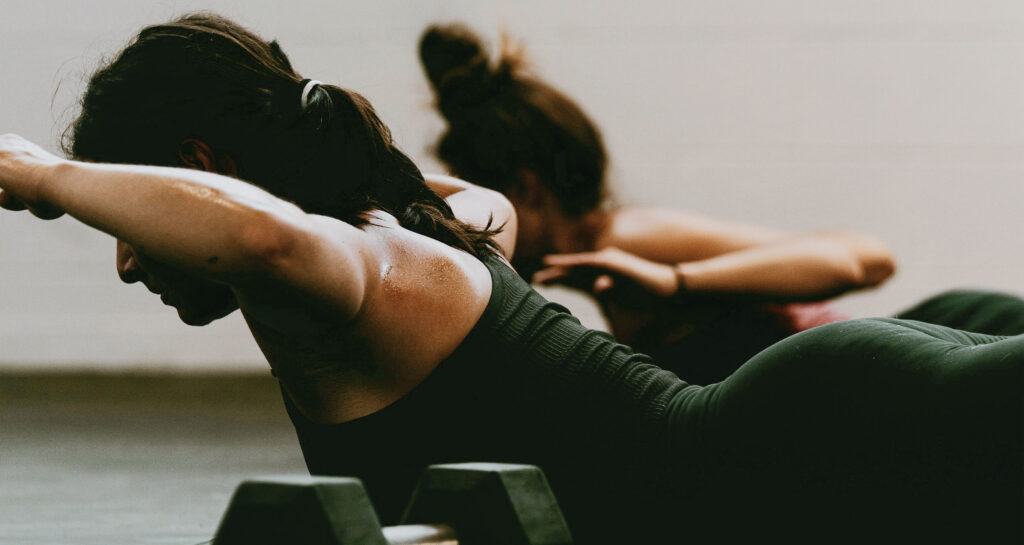Strength training 101 for women
Published on June 9, 2025

Strength training for women hasn’t always been mainstream. Like many women, I avoided weights in the gym for years. In college, I opted for running or other forms of cardio, afraid that weighted exercises would make me “bulky.” When I became pregnant with my first child and running was no longer a good fit for my movement goals, I ventured into strength training—and have never looked back.
The fear that weights will make women bulky has held many of us back, but the opposite is true. While weighted exercises, including resistance bands and bodyweight, do build muscle, they also burn excess fat. When we lift weights, our muscles have to contract, grow, and repair themselves to adapt to how we’re trying to perform. This process, when done safely, builds strength and lean muscle, not bulk.
While cardio exercises are also important, especially for heart health, incorporating strength training into your exercise routine might bring more strength, energy, and balance to your fitness. I’m not a personal trainer, but here are some simple ways to begin:

1. Start with bodyweight.
Bodyweight exercises are incredibly effective, as they use one’s body as the resistance — and our bodies weigh a lot! If you’re looking to build strength, start adding basic bodyweight exercises into your day, such as push-ups, squats, or lunges. You can try to structure a quick routine around these, such as 1 minute of each exercise with a 15-second break in between, repeated 3-4 times.

2. Look into different types of strength training.
You don’t have to be lifting heavy in a gym to be building strength. Barre and pilates are also types of exercise that rely a lot on bodyweight, while also often incorporating cardio bursts, light dumbbells, or other tools for a fun mixup. I began my strength training journey with barre during my first pregnancy, and it left me excited to progress into other forms while also working on my mobility.

3. When you’re ready, don’t be afraid to pick up those weights.
Whether it’s on a machine at the gym or along with a workout video at home, weightlifting can be healthy and fun to incorporate into your routine. If you’re unsure how heavy to start, try to find a weight level that lets you complete 8-10 repetitions of an exercise with good form, but gets challenging for those last couple of reps. This will help you progressively build strength and move up in weights safely and effectively.
Don’t jump right into lifting every day if you are a true novice. Instead, start with 20-30 minutes of weight training 2-3 times per week and see how you feel. Since most experts suggest 30 minutes of a form of exercise daily, strength training a few times a week is plenty for most people. If you’re feeling energized and want more challenge, you can incorporate more weight lifting sessions over time.

4. Decide what works for your season.
Like I mentioned, I moved away from cardio as my main form of exercise when I was in my first pregnancy. During that time, I discovered barre and loved how it made me feel while I was pregnant, so I continued it for a few months postpartum. After a little while, I was craving a different challenge, so I moved into weight lifting, and loved the results! I kept going for a couple of years, even through another pregnancy and early postpartum season (while following the advice of my doctors on my pregnancy and recovery!). While I’ve still incorporated cardio, strength training of some kind has been my main form of exercise for almost 3 years.
Recently, though, I’ve found my body and hormones are seeking the balance that pilates tends to help me achieve. I’ve been doing pilates 3-4 times a week, and incorporating a couple of weight lifting sessions per week as well. I feel more relaxed, while still feeling strong and capable for the season I’m in. I also try to walk every day, whether that’s outside with my kids or on my desk treadmill while I work.
Make every workout count
I share my winding fitness road to showcase that you can change whatever you want, whenever you want, to serve the state you’re in. You don’t have to be a member of a gym or follow current trends to achieve your fitness goals. Fitness and movement should leave us feeling replenished, not depleted. Like many people, I also have very limited time in which to exercise, so I want it to be worth it!
As a woman, it has also helped me to be mindful of my nutrition and cycle when deciding when and how to exercise. I want to honor the design of my body, which means I need to nourish it with plenty of whole, healthy foods, prioritizing protein with each meal, and be aware of where I’m at in my cycle and structure my training around it. If I’m on my period, it’s not the time to over-exert myself — instead, I opt for gentler options such as a longer walk or some mobility work. If I’m in my ovulatory phase, however, I’m more motivated to challenge myself and might add in an extra weight lifting session.
Strength training can be intimidating at first, but quickly becomes exciting, fun, and challenging if you decide to incorporate it. Listen to your body and your needs, and don’t be afraid to start!
If you’re looking for at-home programs to help you with strength training (including during pregnancy and postpartum), I suggest the following:




Check out Healthy Catholic Moms! Brittany has awesome strength training programs (including pilates) that are affordable and effective!